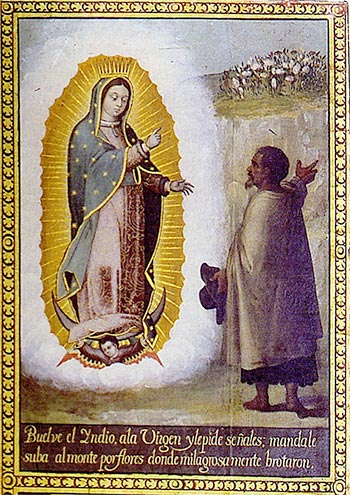The first canvas of the Virgin of Guadalupe with the historical cycle in Agreda

PhotoCedit/Canvasof the Virgin of Guadalupe with the cycle of her apparition, by José Juárez, 1656. Monastery of the Immaculate Conception of Ágreda
An excellent collection of 17th- and 18th-century paintings of the Virgin of Guadalupe in Mexico can be found throughout the Iberian Peninsula. The paintings are often signed by outstanding New Spain painters such as Juan Salguero, Juan Correa, Juan Rodríguez Juárez, Francisco Antonio Vallejo, José Páez and Antonio de Torres. Most of them belong to the 18th century and their history is closely linked to that of so many other Indians who made degree program military, commercial or political in the lands of New Spain.
The success of that Marian icon is already attested to in the second half of the 17th century by the Jesuit Francisco de Florencia, when he states in his monograph on the history of the Virgin of Guadalupe that there were "infinite Images, copies of this miraculous portrait, which have been made throughout this very large Kingdom; for there will not be found in all the Church, Chapel, house, or hut of Spanish or Indian, in which there are not seen and adored Images of Our Lady of Guadalupe... I doubt, or rather, I do not doubt, that more copies of another Image of Mary have been taken in the world than of this one of Guadalupe of Mexico... in Flanders in Flanders in Mexico.... Señora de Guadalupe... I doubt, or rather, I do not doubt, that more copies have been made in the world of any other image of Mary than of this one of Guadalupe in Mexico... in Flanders in Spain, and in all of New Spain, there are so many plates and engraved panels... that there is no number to count them".
Generally, the Virgin is represented according to the apocalyptic outline repeated ad nauseam, crowned and with the golden burst of the sun, in a prayerful attitude, with the average moon at her feet held by an angel. She wears a pink tunic and blue cloak, traditional colours for the Virgin, the former being in biblical times typical of maidens and the latter as a symbol of the unalterable colour of the sky.
In many cases, the painting remained in the Indiano's native home, while in others it acquired greater significance by being hung in a shrine, parish or chapel of special significance.
The painting in Agreda: dated 1656 and its contextualisation
The origin of the canvas, signed by José Juárez in 1656, can be traced back to a donation to the famous Sister Mª Jesús de Ágreda by Francisca Ruiz de Valdivieso (1614-1677), chambermaid to the Duchess of Alburquerque, whom she served in New Spain between 1653 and 1662. Some years ago, in 2002, we were able to read the date of the painting correctly and document it as a contribution by Doña Francisca Ruiz de Valdivieso, who eventually entered the cloister of Agreda in 1662. When this illiterate woman returned from the Indies and after serving the Alburquerque family as a trustworthy woman, she did it with a great number of artistic pieces and 30.000 ducats, which reverted in the convent of Agreda. The issue list of pieces preserved from her bequests is still impressive (outstanding ivories, plates, canvases, Tarascan Christ, monstrance, chalice, chalice, basin) and even more surprising is the list of missing pieces of silver, textiles, plumary art, lacquers... etc.).
In our study, we have already made some progress on the early nature of the Guadalupan canvas, but it is undoubtedly Professor Jaime Cuadriello who has contextualised and assessed the painting with the wisdom of someone who knows topic like no one else. He pointed out that in addition to being a mock altarpiece, it is not only the first vera effigie to reach Spain that we know of, but also the third oldest faithful copy in the world, after the great paintings of the First Miracle and The Indigenous Procession before the Epidemic of Cocolixtli, in the Museum of the Basilica of Guadalupe (1653). As if that were not enough, it is the only known work by the painter José Juárez of topic guadalupano. It undoubtedly evokes the way he saw the arrangement of the four passages in the sanctuary, which guarded the original icon.


Scenes from the cycle of the apparition of the Virgin of Guadalupe, by José Juárez, 1656. Monastery of the Purísima Concepción de Ágreda
It is, therefore, in the opinion of Professor Jaime Cuadriello, the oldest faithful portrait, as such, of the Holy Original in the world, because those of the processional paintings in the basilica are biased and distorted. The oldest documented copy, which was worshipped in the convent of Santo Domingo in 1633, disappeared and the supposed painting by Echave Orio of 1606 was a much later production, from the end of the 18th century.
These days it can be seen at the Prado Museum at exhibition degree scroll Tornaviaje. Arte iberoamericano en España, where you can see other pieces from the convent in Soria and a careful selection of very interesting works from different places such as Mexico and Peru.
To find out more
CUADRIELLO, J., Vera Effigie Guadalupana. Una intervención / intercesión a nombre de Baltazar de Echave Orio, Mexico, Ediciones Zihua, 2018.
CUADRIELLO, J., "Retratos / relatos que vienen de Ultramar: la representación material como metáfora social", Tornaviaje. Arte iberoamericano en España, Madrid, Museo del Prado, 2021, pp. 51-77.
FERNÁNDEZ GRACIA, R., Arte, devoción y política. La promoción de las artes en torno a sor María de Ágreda, Soria, Diputación Provincial de Soria, 2002.
FLORENCIA, F. de, La estrella del Norte de Mexico aparecida al rayar el día de la luz evangélica en este Nuevo Mundo... México, María de Benavides, 1688.
